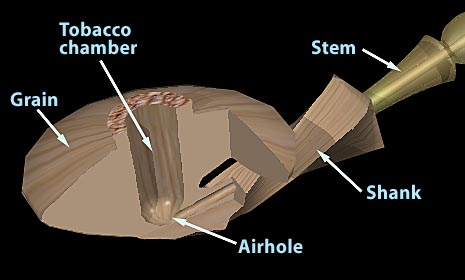
|
Tobacco chamber or cavity
The portion of the pipe in which tobacco is placed, obviously. Carbonizing (or blackening) the interior of the tobacco chamber supposedly lets a pipe be broken in easier, but it also serves to hide a pipe's flaws. Note that Mark's pipes are never carbonized. (The chamber is even in tone; I let a grain show in the illustration to highlight it.) The chamber may have straight sides or be conical.
Shank or neck
The connection between stem and bowl. It may be rather long or very short; some folks believe that the longer the neck, the better the smoke.
Airhole
The intersection of the air shaft through the shank and into the tobacco chamber. The typical preference is that the airhole should be as close to the bottom of the chamber as possible.
Grain
A measure of the quality of a pipe. A straight-grain pipe (that is, one in which the grain lines are even and parallel with one another) is considered to be the highest quality in terms of promising an excellent smoking pipe. (However, an interesting grain shape may hold its own fascinations.)
Stem
The connection between the pipe and the smoker. Generally made of vulcanite (i.e., hard rubber) or lucite, the stem is also known as the mouthpiece. Vulcanite (only in black) is softer but wears out faster; lucite comes in a variety of colors and transparencies.